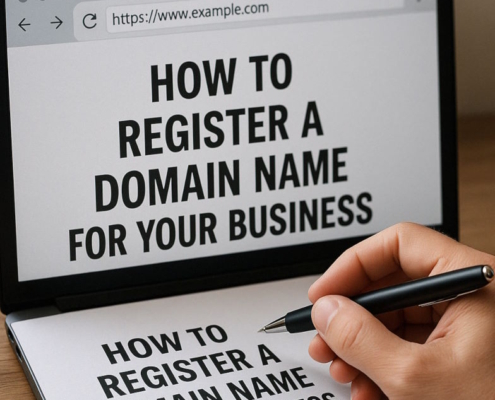Introduction
Your online address is represented by a personalized domain name. It is a component of the URL that appears at the top of the browser window and enables customers and visitors to find the website and send you an email. It also allows you to take charge of your internet persona.
Instead of building a website, many companies choose to use social media. Despite being free and not requiring a domain name, social media accounts put your company in danger of being deactivated, disguised by algorithms, and subject to the platform’s content guidelines.
By just relying on social media accounts, some companies have unintentionally lost countless viewers. By choosing to register a domain, you can create a consistent online identity and establish credibility. The procedure to register a domain is simple and requires little money and time.
1. Choose a Domain Name
Selecting the desired name is the first part of acquiring a domain name. Avoiding domain name changes wherever feasible is typically seen as best practice, though you might modify it by establishing a new name afterward.
Rules for Domain Names
There are some limitations on what can be used as the domain name, although there are not very many. Sections, for instance, cannot exceed 63 characters. You won’t likely reach that maximum, though, unless you’re composing a paper on the lung ailment.
Key guidelines for domain names are:
- Only English-language numerals and letters are permitted; unusual characters are not.
- Though they are not permitted at the start or finish of a domain name, hyphens are allowed.
- Absence of hyphen strings
- No blanks
- The length of a domain name shall not exceed 253 characters overall and must range from 3 to 63 characters for each segment.
- There is no case difference in domain names.
Best practices for domain names
There are a number of best practices that can help you make a domain name memorable and steer clear of pitfalls, even beyond registration constraints.
- Limit names to 20 characters.
- Choose a name that is most similar to your company name.
- When employing more than one word, use caution to prevent awkward pairings.
- Employ standard spellings.
- Steer clear of names that sound like major brands.
Tips for picking a domain name
Generating at least five or six potential names is something I personally like to do before determining availability. This is due to the fact that when your desired name isn’t accessible, it’s easy to become angry. If you don’t have a list of potential names ready, this aggravation frequently results in registering a subpar domain name in an attempt to launch a website. A poor choice under pressure could lead to you having to register a domain that doesn’t represent your brand well.
At most registrars, domain name generators are offered to assist with name brainstorming. Many of them, however, check availability simultaneously, which can lead to a vicious cycle of searching for anything rather than actually choosing names that would be suitable for your company.
I would rather use an independent system, like Perplexity.ai, to solicit name recommendations in order to avoid that. Although many of these are lifted verbatim from articles about domain name possibilities, they frequently give me ideas for where to begin.
When choosing your list of potential names, keep in mind that some phrases, such as tech or SaaS, typically have higher prices if they are included in the domain name.
Which domain extension is the best?
The space after the dot is called a domain extension. Domain extensions include, for instance, .com and .org. Another name for domain extensions is TLDs (top-level domains). Only a small portion of the dozens of TLDs that are available are carried by the majority of domain registrars.
The operation of certain domains is delegated to other organizations by the ICANN (Internet Corporation for Assigned Names and Numbers), which also controls which TLDs are accessible (except from country-specific TLDs). The authority to sell the usage of TLDs to third parties is then purchased by registrars.
Public use is prohibited for some TLDs. For instance, registering a domain name that ends in .mil, .gov, or .arpa is not permitted. Certain TLDs are also controlled by organizations; for example, only registered realtors are authorized to use .realtor.
Your company’s needs will determine which domain extension is ideal. The public trusts more well-known TLDs like .com, .info, and .net, but specialty TLDs like .tech for technical firms, .shop for e-commerce, .music for artists, and .art for artistic companies are rapidly gaining traction.
The price of some domains varies as well. In general, .tech TLDs are more expensive than .com domains, for instance. When you register a domain, choosing the right extension is just as important as the name.
2. Select a registrar for domain names
It matters where you register a domain. For instance, a hosting plan may include a complimentary domain name for the first year when you have already chosen a web host. You need to carefully read the conditions of use because, contingent upon the host, it may register a domain under its name rather than yours.
To make sure you are actually purchasing the domain name, you should also search for a registrar that has been accredited by ICANN.
When selecting a registrar, I prefer to compare prices to find out what is covered by the registration, renewal costs, and transfer fees in case I decide to transfer the domain to a different registrar in the future.
It should be noted that not every registrar provides all TLDs, and a few charge more for SSLs or Whois domain privacy.
Which domain name registrar is the best?
The top domain registrars are well-known and frequently offer complimentary services like SSLs and Whois domain privacy, although they all have distinct pricing policies. Namecheap is well-known for offering inexpensive names, however, they charge more for SLL and “quality” DNS. Dynadot frequently has exorbitant renewal fees, however, it provides a fantastic introductory cost with complimentary domain privacy.
3. Purchase a domain name
Although everyone says, “purchase a domain,” you are merely getting a license to use the domain name for a predetermined amount of time when you register a domain. Every domain registrar approaches licensing differently, as was previously said, and is free to establish rates since ICANN removed domain limitations on some TLDs.
Due to worries about skyrocketing prices as a result of the judgment, Namecheap sued to restore price limitations to .org domains in 2024.
How to proceed after obtaining a domain name
Once you register a domain, you must now configure it. Unless, of course, you purchased it from your web provider. In most cases, pointing is handled automatically by the host if you establish a domain with them.
Using the dashboard of your domain registrar, you can update the DNS (domain name servers) if you want to point the domain yourself. Almost all domain registrars have excellent instructions to guide you through the procedure, however it can differ slightly. Basically, all you have to do is copy and paste some code between the registrar and your web host.
In conclusion, include the newly registered URL in all of your company’s documents, including email signatures, stationery, and social media accounts, including the Google Business profile. When you register a domain, you will then have a single point of contact for all media.






























